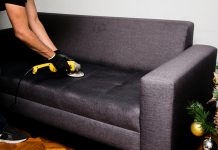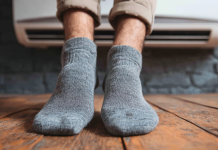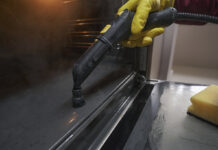Popcorn ceilings are a popular home decorating trend that has been around for decades, but over time they can collect mold and other mildew which can be a nuisance.
Unfortunately, mold growth on popcorn ceilings is not something you can just wipe off with a rag. Instead, to get rid of this type of mold you will need to do some more intense cleaning. How? Below we’ll explore different ways you can easily remove mold on popcorn ceilings.
What is the popcorn ceiling?
There are many types of ceilings in residential homes, but one of the most common types of ceilings seen in homes is the popcorn ceiling. The popcorn style ceiling was popularized in the mid-1970s and it is still widely used today, however, it has more of a modern edge than it did 30 years ago.
Popcorn ceilings are typically found in low-ceiling rooms such as hallways and bathrooms where sound is not important. Click here to learn more on different bathroom decor styles.
Protective gear you’ll need
- Safety glasses
We recommend you get a solid pair safety glasses that are scratch resistant and with anti-fog capabilities to protect your eyes from debris that may fall as you clean the black spots on the popcorn ceiling.
- Mask
Mold is a serious concern for people with asthma, allergies, lung disease, and other respiratory conditions. Mold can spread quickly in damp areas of the home or work environment. Exposure to mold spores can irritate your eyes, nose, throat, skin, lungs, and nasal passages. Wearing a mask when cleaning mold is recommended to protect against its harmful effects
- Protective gloves
Before you start cleaning, put on a pair of protective gloves to protect your skin against the mold.
- Other must-haves
This includes disposable clothes and cleaning supplies. Also, if you have other furniture around, make sure to cover them with plastic to prevent spreading of the spore.
Cleaning products you’ll need
- Scraper
- Warm water and sponge
- Detergent
- Clean cloth
- White vinegar
- Baking soda
How to clean mold on popcorn ceiling
Method 1
One of the most basic ways to clean mold on popcorn ceilings is by using warm water and sponge.
Dip the sponge in water and dab the affected area. Ensure you have soaked the area and leave it for 5 – 10 minutes.
With a bowl of clean water, rinse the ceiling thoroughly. Wipe the surface with a clean cloth. Repeat the process as many times as needed.
Method 2
The second method involves using a solution of water and baking soda. According to studies, baking soda has properties that help dissolve mold easily in water. Plus its great at deodorizing odors.
First, start by sweeping or vacuuming the moldy area. Then pour and mix ½ a cup of baking soda in warm water. Then pre-wash your ceiling with this solution and wait for a few minutes for the area to soak.
Rinse the ceiling and dry it with a cloth.
Method 3:
The third method is by using a solution of one cup bleach and a bucket of warm water. Put the solution in a sprayer and spray the white or black mold on the popcorn ceiling. Using a sponge, gently dab the solution into the nubs and crannies. Wait for a few minutes for it to soak then rinse with warm water and clean cloth. Let the ceiling dry overnight before putting in measures to prevent mold from recurring.
Causes of mildew and mold growth on ceiling
Mold growth occurs mostly in damp areas around a home. Popcorn ceilings, especially in bathrooms and the basement, are mostly affected by mold growth. Other common causes of mold growth include:
- Bad ventilation
- Roof leaking
- Cooking
- Leaking pipes
- High humidity in basements
What does mold look like on popcorn ceilings?
Not sure if it’s mold? If its checks these boxes, it is mold growth
- Check if the discoloration is black or white sometimes yellow/brown
- Most often the staining appears in circular patterns
- Growth often occurs in one spot
How to prevent mold on popcorn ceiling
Humid areas around the house are more susceptible to mold growth. Here are a few tips to help you protect your home from recurrence of ceiling mildew and mold.
- Lower humidity levels
If your basement is very humid, you can reduce the humidity levels by installing a dehumidifier. A good dehumidifying machine should be easy to turn on and automatically shut off. It should adjust the humidity easily and auto-drain. You don’t have to get a high-end dehumidifier, just ensure you get one that is perfect for your room’s size.
- Remove any wet furniture
In case of flooding, be sure all your furniture and carpets are well dried before placing them back in the room. This prevents mold growth in your home.
- Check the ventilation
Poor ventilation contributes to mold growth. Check if your ventilation and air conditioners are working perfectly.
- Repainting
After cleaning the affected area, we recommend you seal and repaint it. Use a mold sealant and anti-mold paint. This ensures your cleaning efforts don’t go to waste.
- Leaks
Fix any leaking pipes. Not sure how to go about it, you can contact professional plumbers near you.
Faqs!
Should I paint over mold on the popcorn ceiling?
No. Painting over black mold on the popcorn ceiling will not remedy the problem. This fungus will keep thriving under the paint and spread to other areas in your home. Experts recommend you clean the area first then paint it over with anti-mold paint.
Is it bad to have mold on your ceiling?
According to the CDC a moldy environment is bad for your health. This fungus has adverse health effects especially for people with allergies.
Can opening windows reduce mold?
It is unlikely to find this fungus in open spaces. So, yes, opening your windows will reduce and prevent growth of mold and mildew.
Final Thoughts
Mold stains on your ceiling are not only unsightly, but they can also be detrimental to your health. This article provides you with a step-by-step process to eliminate the mold that has taken up residence in your popcorn ceiling. After cleaning, ensure you’ve taken proper preventative measures to ensure the problem does not recur.
















